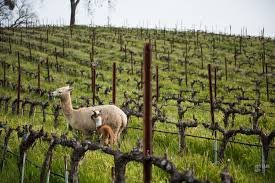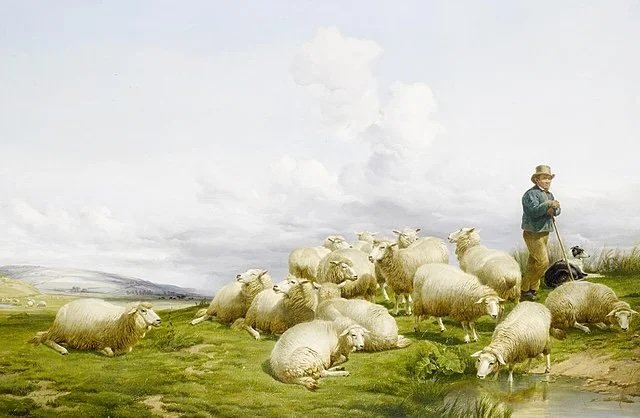Sheep in vineyards
Nikita Malhotra
May 8th, 2025
Raj and Daniel in Burgundy
The La Paulée team loves sheep!
I was recently asked if I wanted to go on a trip to Georgia for a week, a trip that would explore a tradition with wine that goes back thousands of years. Timing didn’t work out, and instead I had a chance to welcome all the Italian winemakers who visited New York last weekend for our first annual Convivio del Vino. But I was allowed to select someone to take my coveted spot, and so I nominated my friend Jacob. He’s the last person I remembered drinking a bottle of Georgian wine with and he just finished all of the volumes of Robert Caro’s LBJ series, so I felt I could trust him to take some notes and at least my proxy might bring some perspective that the average wine professional wouldn’t. As I checked my phone for updates on his trip last week a trickle of videos of sheep in vineyards began to accumulate. Frazzled sheep in need of a fresh shear, cute sheep peaking their heads out of the vines and trying to lick the amber colored wine out of small bistro style glasses, and sheep and a variety of other animals sharing the space in these ancient vineyards. Looking at his social media posts I found the wine and cultural content I would have expected as well as a good amount of kitten content, seems like there are many cute stray cats in Georgia; wait, was I the only one receiving sheep content? Maybe Jacob was guiding me, unknowingly, to acknowledge not only my love of sheep, but also this was a nudge to consider the relationship with sheep and vineyard management.
Before delving into the history and benefits of sheep in the vineyards, I would like to share an early memory of combing wool as a child. I went to Waldorf School here in New York City, and so this was oddly something I remember doing quite often alongside knitting and crocheting. Our school had satellite farms upstate and in Pennsylvania, and so we had ample supply of wool and endless hours of combing that filled our long wonder filled days as children. What I remember most about this activity is the smell of lanolin on my hands, and how that musty smell persisted and formed a strong memory, I can picture the carpeted room with woolen dolls and wooden furniture and soft hues of blue, yellow and pink that I spent time in. When I started to seriously taste wine, that room and those smells came to haunt me when I tasted certain Loire Valley Chenin Blancs. I secretly wanted those more funky, wet wool, almost feral wine over the more precise and riper fruit and cleaner interpretations. So even at the beginning of my wine career, I had unknowingly had sheep at the back of my mind.
Make it stand out
Raj got to visit the sheep at Phelan Farm last year in California.
So why are sheep good for vineyards? Sheep serve the dual purpose of providing weed control and natural fertilizer. Shepherding stands as one of the most ancient vocations and is a marker for our transition from nomadic to a settled agrarian lifestyle. Our historical relationship with vines also provides insight into this particular transition, as we began to cultivate the land around our settled spaces. So much of husbandry has been transformed by technology and modern systems, but the image of sheep grazing and the shepherd guiding his flock is still recognized and appreciated through time. The Romantic movement in literature and art in the 19th century helped preserve this tradition even as urban life continued to dominate with factories and large populations changing the landscape and in turn changing our relationship with domesticated animals and crops. The advent of synthetic fibers and a shift in prioritizing land for crops as food consumption posed a challenge to the traditional shepherding practices. Our contemporary interests in sustainability and conservation and diversity in farming has shifted this role and this is where we are seeing more sheep in the vineyards.
Winemakers have been returning to old school practices, encapsulating a holistic approach to farming, and visiting the vineyards you can see a difference between those who prescribe to this approach, even without animals playing between the vines; the difference between a healthy vineyard, one teeming with life and energy, and a vineyard that has been consistently treated with chemicals, bringing about an almost martian feeling to the landscape, is vast and stark. We talk a lot about farming practices, and regenerative farming is a topic that holds just as much interest as sustainable, organic or biodynamic. One of the best arguments I have heard in regards to using sheep has to do with the concept of terroir, because bringing in compost or manure from another place is taking something that doesn’t belong and putting it in the vineyards. And if you begin to have other animals such as pigs and chickens and such then you get to create a unique environment with a self-sustaining ecosystem. Many wineries are committed to using sheep because it does decrease the need to use pesticides, and I think a majority of us do care what we end up putting in our bodies, but I think there is also something romantic and nostalgic and very much in line with how many of us view wine.
For the wine drinker, wine isn’t just a beverage, and I think this translates to how one would like to farm as well. I could look at nitrogen levels in the soil from studies of vineyards that have switched to having sheep graze in their vineyards for five years, but instead I will take a cue from the story when I combed wool as a child. I hold that memory with me because it preserves something magical, and that a glass of Chenin Blanc can take me back to that place is joyful. I think Jacob sent me all those pictures of sheep because of that sense of wonder and joy. Making wine is quite technical, but it can be magical as well. And when you see sheep alongside the vines you can feel that sense of beauty, a moment where the veil of reality lifts and you are surrounded by wonder and awe. I hope you enjoy the sheep on your next visit to a vineyard, and remember, I will always look forward to any pictures you might want to send of these adorable animals.




